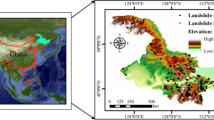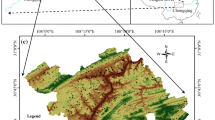Abstract
Understanding the extent of landslide damage is important for reducing the impact of landslides, which can cause great losses of life and property. Although numerous studies have been done on landslide disaster susceptibility, they have been limited by an unreasonable negative sample selection strategy or the absence of subjective environmental information of the study area in a single machine learning evaluation model. To evaluate landslide susceptibility based on sample optimization, we propose an analytic hierarchy process (AHP) method weighted by an improved random forest (RF) model. Based on the density analysis of landslide data, this method employs the certainty factor (CF) method to generate negative sample data. Correspondingly, ADB_RF, an enhanced RF model based on adaptive boosting (AdaBoost) is proposed to obtain objective weights, which are then combined with subjective weights obtained by the AHP (CF-combination). Additionally, a case study on the evaluation of landslide disasters was conducted in the Chuxiong Autonomous Prefecture of Yunnan, China. The results show the following: (1) the proposed landslide susceptibility evaluation method could objectively reflect the area prone to landslides with a high degree of accuracy and efficacy. (2) The area under the curve (AUC) of the CF-combination model reached 96.1%, indicating a high degree of accuracy. (3) In the northwestern region of Chuxiong Prefecture, more extremely high-risk areas were found than in the southeast; therefore, it has a high likelihood of experiencing another landslide disaster, which requires special attention. Accordingly, the research findings have significant reference value for preventing disasters and mitigating losses.





































Similar content being viewed by others
References
Breiman L (2001) Random forests. Mach Learn 45(1):5–32. https://doi.org/10.1023/A:1010933404324
Carrión-Mero P, Montalván-Burbano N, Morante-Carballo F, Quesada-Román A, Apolo-Masache B (2021) Worldwide research trends in landslide science. Int J Environ Res Public Health 18(18):9445. https://doi.org/10.3390/ijerph18189445
Chen X, Chen W (2021) GIS-based landslide susceptibility assessment using optimized hybrid machine learning methods. CATENA 1(196):104833. https://doi.org/10.1016/j.catena.2020.104833
Cheng J, Dai X, Wang Z, Li J, Qu G, Li W, She J, Wang Y (2022) Landslide susceptibility assessment model construction using typical machine learning for the Three Gorges Reservoir Area in China. Remote Sens 14(9):2257. https://doi.org/10.3390/rs14092257
Cui C, Yao X, Xu L, Chao Y, Hu Y, Zhao S, Hu Y, Zhang J (2023) Improving the classification of PCNSL and brain metastases by developing a machine learning model based on 18F-FDG PET. J Pers Med 13(3):539. https://doi.org/10.3390/jpm13030539
Das S, Sarkar S, Kanungo DP (2022) GIS-based landslide susceptibility zonation mapping using the analytic hierarchy process (AHP) method in parts of Kalimpong Region of Darjeeling Himalaya. Environ Monit Assess 194(3):234. https://doi.org/10.1007/s10661-022-09851-7
Froude MJ, Petley DN (2018) Global fatal landslide occurrence from 2004 to 2016. Nat Hazards Earth Syst Sci 18:2161–2181. https://doi.org/10.5194/nhess-18-2161-2018
Ganaie MA, Tanveer M, Suganthan PN, Snasel V (2022) Oblique and rotation double random forest. Neural Netw 153:496–517. https://doi.org/10.1016/j.neunet.2022.06.012
He Y, Zhang Y (2022) Comparison of three mixed-effects models for mass movement susceptibility mapping based on incomplete inventory in China. Remote Sens 14(23):6068. https://doi.org/10.3390/rs14236068
He W, Chen G, Zhao J, Lin Y, Qin B, Yao W, Cao Q (2023) Landslide susceptibility evaluation of machine learning based on information volume and frequency ratio: A case study of Weixin County. China Sens 23(5):2549. https://doi.org/10.3390/s23052549
Huang Y, Zhao L (2018) Review on landslide susceptibility mapping using support vector machines. CATENA 165:520–529. https://doi.org/10.1016/j.catena.2018.03.003
Huang W, Ding M, Li Z, Zhuang J, Yang J, Li X, Meng L, Zhang H, Dong Y (2022) An efficient user-friendly integration tool for landslide susceptibility mapping based on support vector machines: SVM-LSM toolbox. Remote Sens 14(14):3408. https://doi.org/10.3390/rs14143408
Izquierdo-Horna L, Zevallos J, Yepez Y (2022) An integrated approach to seismic risk assessment using random forest and hierarchical analysis: Pisco. Peru Heliyon 8(10):e10926. https://doi.org/10.1016/j.heliyon.2022.e10926
Ke K, Zhang Y, Zhang J, Chen Y, Wu C, Nie Z, Wu J (2023) Risk assessment of earthquake–landslide hazard chain based on CF-SVM and Newmark model—Using Changbai Mountain as an example. Land 12(3):696. https://doi.org/10.3390/land12030696
Kincal C, Kayhan H (2022) A combined method for preparation of landslide susceptibility map in Izmir (Türkiye). Appl Sci 12(18):9029. https://doi.org/10.3390/app12189029
Leal JE (2020) AHP-express: A simplified version of the analytical hierarchy process method. MethodsX 7:100748. https://doi.org/10.1016/j.mex.2019.11.021
Li L, Chen X, Zhang J, Sun D, Liu R (2022) Landslide susceptibility-oriented suitability evaluation of construction land in mountainous areas. Forests 13(10):1621. https://doi.org/10.3390/f13101621
Liu Y, Meng Z, Zhu L, Hu D, He H (2023) Optimizing the sample selection of machine learning models for landslide susceptibility prediction using information value models in the Dabie Mountain Area of Anhui. China Sustain 15(3):1971. https://doi.org/10.3390/su15031971
Matougui Z, Djerbal L, Bahar R (2023) A comparative study of heterogeneous and homogeneous ensemble approaches for landslide susceptibility assessment in the Djebahia region Algeria. Environ Sci Pollut Res. https://doi.org/10.1007/s11356-023-26247-3
Mwakapesa DS, Mao Y, Lan X, Nanehkaran YA (2023) Landslide susceptibility mapping using DIvisive ANAlysis (DIANA) and RObust Clustering using linKs (ROCK) algorithms, and comparison of their performance. Sustainability 15(5):4218. https://doi.org/10.3390/su15054218
Piciullo L, Calvello M, Cepeda JM (2018) Territorial early warning systems for rainfall-induced landslides. Earth Sci Rev 179:228–247. https://doi.org/10.1016/j.earscirev.2018.02.013
Ramos-Bernal RN, Vázquez-Jiménez R, Cantú-Ramírez CA, Alarcón-Paredes A, Alonso-Silverio GA, Bruzón AG, Arrogante-Funes F, Martín-González F, Novillo CJ, Arrogante-Funes P (2021) Evaluation of conditioning factors of slope instability and continuous change maps in the generation of landslide inventory maps using machine learning (ML) algorithms. Remote Sens 13(22):4515. https://doi.org/10.3390/rs13224515
Saha A, Villuri VGK, Bhardwaj A (2022) Development and assessment of GIS-based landslide susceptibility mapping models using ANN, Fuzzy-AHP, and MCDA in Darjeeling Himalayas, West Bengal. India Land 11(10):1711. https://doi.org/10.3390/land11101711
Segoni S, Piciullo L, Gariano SL (2018) A review of the recent literature on rainfall thresholds for landslide occurrence. Landslides 15:1483–1501. https://doi.org/10.1007/s10346-018-0966-4
Sharma A, Prakash C, Manivasagam VS (2021) Entropy-based hybrid integration of random forest and support vector machine for landslide susceptibility analysis. Geomatics 1(4):399–416. https://doi.org/10.3390/geomatics1040023
Wang Y, Fang Z, Hong H (2019) Comparison of convolutional neural networks for landslide susceptibility mapping in Yanshan County, China. Sci Total Environ 666:975–993. https://doi.org/10.1016/j.scitotenv.2019.02.263
Wei X, Gao W, Hu R, Gao W, Qiu Y, Li Y (2023) Forecasting the failure time of an expansive soil slope using digital image correlation under rainfall infiltration conditions. Water 15(7):1328. https://doi.org/10.3390/w15071328
Wohlers A, Damm B (2022) Rockfall vulnerability of a rural road network—A methodological approach in the Harz Mountains. Germany Geosci 12(4):170. https://doi.org/10.3390/geosciences12040170
Yesilnacar E, Topal T (2005) Landslide susceptibility mapping: A comparison of logistic regression and neural networks methods in a medium scale study, Hendek region (Turkey). Eng Geol 79(3–4):251–266. https://doi.org/10.1016/j.enggeo.2005.02.002
Zhang R, Wu S, Xie C, Chen Q (2022) Risk monitoring level of stope slopes and landslides in high-altitude and cold mines. Sustainability 14(13):7581. https://doi.org/10.3390/su14137581
Zhou X, Wu W, Qin Y, Fu X (2021) Geoinformation-based landslide susceptibility mapping in subtropical area. Sci Rep 11:24325. https://doi.org/10.1038/s41598-021-03743-5
Zhou J, Tan S, Li J, Xu J, Wang C, Ye H (2023) Landslide susceptibility assessment using the analytic hierarchy process (AHP): A case study of a construction site for photovoltaic power generation in Yunxian County. Southwest China Sustain 15(6):5281. https://doi.org/10.3390/su15065281
Acknowledgements
We thank anonymous reviewers for their constructive comments and recommendations for this manuscript. We are also grateful to LetPub for the English revision of this manuscript.
Funding
This work was supported by the Beijing Key Laboratory of Urban Spatial Information Engineering (NO. 20230101) and the National Natural Science Foundation of China (No. 41871367).
Author information
Authors and Affiliations
Contributions
All authors contributed to the study conception and design. Material preparation, data collection, and analysis were performed by HX, XZ, and ZX. The first draft of the manuscript was written by HX, XZ, ZL, and BC, and all authors commented on previous versions of the manuscript. All authors read and approved the final manuscript.
Corresponding author
Ethics declarations
Competing interests
All authors declare that they have no conflict of interest.
Additional information
Publisher's Note
Springer Nature remains neutral with regard to jurisdictional claims in published maps and institutional affiliations.
Rights and permissions
Springer Nature or its licensor (e.g. a society or other partner) holds exclusive rights to this article under a publishing agreement with the author(s) or other rightsholder(s); author self-archiving of the accepted manuscript version of this article is solely governed by the terms of such publishing agreement and applicable law.
About this article
Cite this article
Zhang, X., Xie, H., Xu, Z. et al. Evaluating landslide susceptibility: an AHP method-based approach enhanced with optimized random forest modeling. Nat Hazards (2024). https://doi.org/10.1007/s11069-023-06306-1
Received:
Accepted:
Published:
DOI: https://doi.org/10.1007/s11069-023-06306-1




